The 1960s were a pivotal decade for fashion, and the hippie movement had a significant impact on clothing styles during that era. Hippie fashion was a reflection of the counterculture and anti-establishment sentiments of the time.
The History
In the 1960s, the world was in a state of flux. Civil rights activists were fighting against racial discrimination, and the Vietnam War loomed large, causing deep divisions. In this turbulent era, the hippie movement emerged as a response to the prevailing establishment norms. Hippie fashion was more than just clothes; it was a form of protest and a way to express dissent.
While San Francisco was a focal point of the hippie movement, similar trends and subcultures emerged in other cities across the United States and around the world. The counterculture spirit transcended geographical boundaries, with young people seeking alternative ways of living and expressing themselves.
Hippie fashion challenged traditional gender roles. Unisex clothing and androgynous styles blurred the lines between masculine and feminine attire. This was groundbreaking at the time, as it allowed people to explore their own identities beyond societal expectations.
By the time I went to college in the Fall of 1968, my entire clothing style changed. Out of my mother’s clutches, I went hippie. Or more accurately, pseudo-hippie. I did not head for San Francisco nor did I live on the streets. But I was dressed appropriately for protest marches, and that’s what matters for this discussion.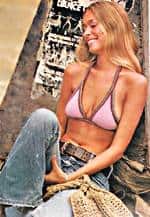
We were so sure we were counter-culture individualists. Radicals! Looking back I realize that you cannot be a non-conformist while conforming to a style all your peers have adopted. But it is fair to say, as a group we had left the mainstream.
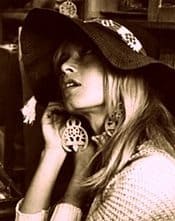
Hats and Headbands
Hats were a prominent part of the hippie look. Flower crowns and Pocahontas-style headbands adorned with feathers or beads were commonly worn.
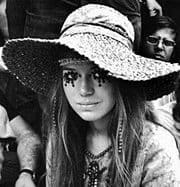
Anything you could tie around your head was popular.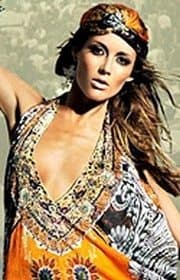
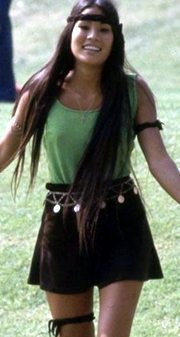
Handmade and Natural Materials
Handmade and natural were sacred words. We crafted by doing macrame, beading, all sorts of homespun things that kids today wouldn’t be caught dead doing. I have no idea how many candles I made but once, I used an empty Mrs. Butterworth syrup bottle. Never mind. It was the Sixties, whaddaya want?
This back to nature bent spilled over into clothes. We wore peasant blouses, granny dresses and carried hemp bags.
There were some serious issues. A nasty little war in Vietnam threatened every male in my age group. Racial inequities needed remedy. But this is the fashion section and we’re going to have some fun with the hippie look. I’m entitled.
Peace, baby.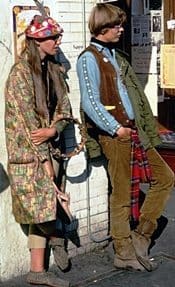
Secondhand Shopping
Many hippies preferred to buy their clothing secondhand from places like thrift stores, flea markets, and army surplus shops. This was in line with their anti-consumerist values. This wasn’t great for retailers either. Shopping at the Army Surplus tends to undercut major department stores.
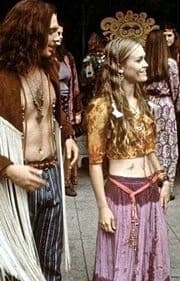
Hair
Long hair was a hallmark of hippie style, often described as “unkempt looking” by some. Despite the free-spirited appearance, hippies generally kept their hair clean.
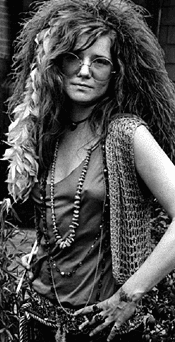
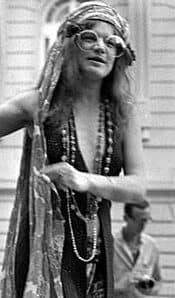
Women’s Clothing
Women often wore peasant blouses, granny dresses (long, flowing dresses with floral prints), and skirts. Mini or micro skirts were also acceptable, but they typically required having decent legs. Chain belts and boots were popular accessories.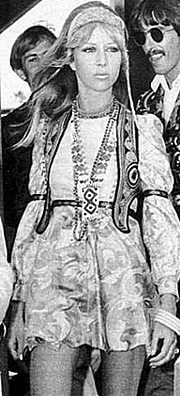
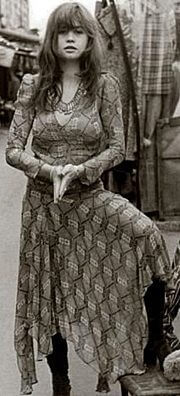
Patty Boyd first wife of both George Harrison and Eric Clapton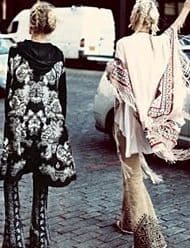
Hippie fashions even influenced more expensive designer clothing
Bell Bottoms
Bell-bottom pants were a major trend of the era. They started off relatively modest in size but gradually became wider as the decade progressed.
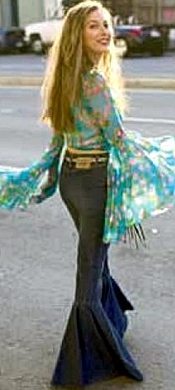
Men
Men favored jeans, often worn in a grungy, worn-in style. Leather vests and fringe were common additions to men’s outfits. The peace symbol was a popular accessory for both genders.
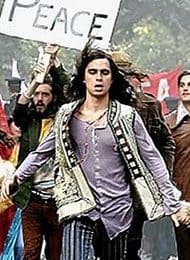
Guys had their own hippie look. This one was running during a peace march.
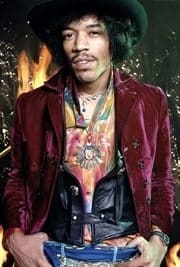
No, most guys didn’t dress like Jimi Hendricks, but jeez he made it cool.
Certainly, here are some additional details and explanations to fill gaps in the text:
How to Dress Like a Hippie
- Do have a flower. I know the song says “in your hair,” but the truth is that it’s hard to get the things to stay put. Flowers were a ubiquitous symbol of peace and love during the hippie era. While the classic image is a flower tucked behind the ear, many hippies opted to wear flowers on their clothing or as part of accessories like flower crowns.
- No flower? Go for the Pocahontas headband. If you couldn’t find a flower, a headband reminiscent of what Pocahontas might wear was a stylish alternative. These headbands were often adorned with feathers, beads, or other natural elements.
- Hair is long and “unkempt looking.” (My mother’s words) But it is clean. Yes, we washed our hair. Hey, deep down we were Baby Boomers from suburbia. The hallmark of hippie hair was its length, often flowing down to the shoulders or beyond. While it may have appeared wild and free, hippies maintained clean and well-groomed hair despite its “unkempt” appearance.
- Women could wear a mini or even micro skirt provided she had decent legs. A chain belt was groovy. Boots or go-go boots were okay too. Hippie women embraced freedom of choice when it came to skirts. Mini and micro skirts were trendy, but they required confidence and what was deemed “decent legs.” Accessorizing with a chain belt and wearing boots or go-go boots completed the look.
- Men – Jeans, the grungier the better. Leather vests were big too. For men, jeans were a staple. The more worn and tattered, the better they represented the anti-establishment spirit. Leather vests were a popular addition to the ensemble, symbolizing a rugged and rebellious attitude.
- Fringe – for all. Vest, jackets, pants, shirts. Anything could be fringed. Fringe was a versatile feature in hippie fashion. It adorned not only vests and jackets but also pants and shirts, adding a bohemian touch to various clothing items.
- Peace symbol. Every last one of us had at least one peace symbol. The peace symbol, often worn as a pendant or on clothing, was a near-universal accessory for hippies. It represented their commitment to peace, love, and non-violence.
Layering
Layering was a key element of hippie fashion. This included adding beads, bangles, vests, and scarves to outfits for a bohemian look.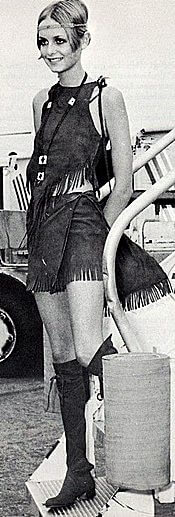
Twiggy proved that the “hippie look” went mainstream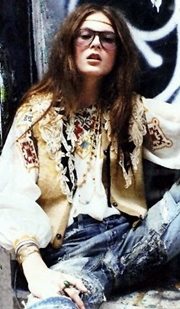
Notice the jeans. We didn’t buy them this way, we wore them until they were old and tattered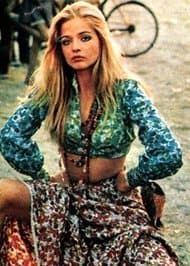
Some of these fashions were bought at the mall but most came from secondhand stores and flea markets.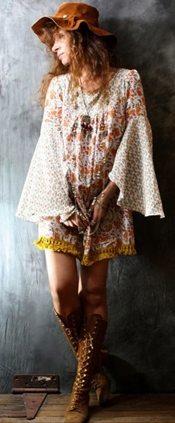
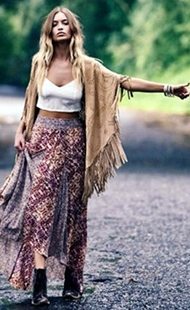
Bet she got a ride!
This skirt would have been way too short for my high school but this girl seems to be getting away with it.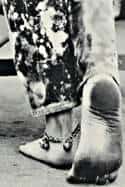
Hippie shoes? Yes, it was considered counter culture cool.
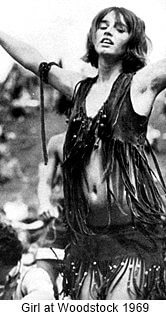
Music, Fashion & Events
Some memorable moments of the hippie era included the “Summer of Love” in 1967, a gathering of thousands in San Francisco’s Haight-Ashbury district to celebrate peace and love. The Woodstock Festival in 1969 became an epitome of counterculture gatherings. Influential figures like Timothy Leary, a proponent of psychedelic experiences, and Abbie Hoffman, a radical activist, played pivotal roles in shaping the counterculture movement.
Music and fashion were inseparable during the 1960s. Bands like The Beatles, The Rolling Stones, Janis Joplin and Jimi Hendrix not only influenced the music scene but also left a profound mark on fashion. Their experimental and free-spirited style resonated with the youth of the time and became a hallmark of the hippie look.
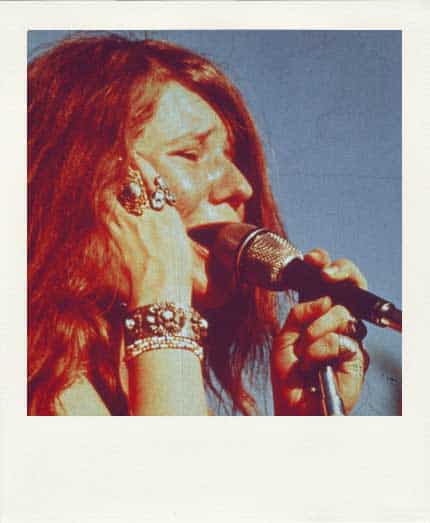
Janis Joplin, a legendary blues singer, she embodied the quintessential hippie look. She often wore flamboyant and unconventional clothing, setting a style that many sought to emulate.
The 1960s hippie fashion movement was about expressing ideals of peace, love, and individuality through clothing. While it may have seemed like a rebellion against conformity, it also created its own fashion subculture with its own set of trends and aesthetics.
The influence of hippie fashion can still be seen in modern clothing. Elements like tie-dye, fringe, and bell-bottom pants continue to inspire designers and find their way into mainstream fashion. The legacy of the 1960s hippie look lives on in the closets of those who value individuality and eco-consciousness.
The legacy of hippie fashion extends beyond the 1960s. It has left an indelible mark on subsequent generations, influencing their values and fashion choices. Even today, the ideals of peace, love, and non-conformity associated with hippie fashion continue to resonate with those who seek a more free-spirited and socially conscious way of life.
